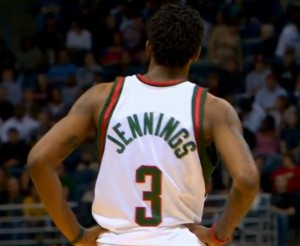If NBA seasons were a collection of Mortal Kombat matches, the Milwaukee Bucks were on the receiving end of a Sub-Zero freezing rain finishing move at the hands of the Charlotte Bobcats.
The Bucks failure to maintain a six point lead with four minutes remaining against a similarly stunted Bobcats offense was closure for a season rife with bad injury luck and general underachievement.
The real or perceived end of a season that started with high expectations always brings “What went wrong?” discussions full circle to auditing the front office, and Bucks GM John Hammond has and will receive criticism for handcuffing Milwaukee’s budget with unmovable contracts to players on the back half of their careers.
By Jake McCormick
There’s no question John Hammond is as responsible for assembling the 2010-11 Bucks roster as a kid is for a failed Sims utopia. But the 2009-10 NBA Executive of the Year deserves at least one mulligan for his lack of control over in-game performance and a risk-taking attitude that was previously unheard of in the Milwaukee Bucks organization.
John Hammond and Bucks center Andrew Bogut haven’t been shy about the limited resources on small market NBA teams. As such, Hammond chose to go for broke in the offseason to bring in better talent to fill the team’s weaknesses (non-Andrew Botgut post play, getting to the line) while reinforcing their strengths (defense, guard scoring). It has failed (so far), but not because of Hammond’s team-building philosophy.
It’s very easy to call the veteran arrivals of Corey Maggette, John Salmons, and Drew Gooden the Bucks’ version of Jeff Suppan. The beauty part about hindsight is that is requires little historical perspective, and allows you to be “right” pretty much all the time. However, Suppan’s tenure as a Brewer mirrors the Bucks’ 2010 free agent class because each player’s acquisition signaled a changing of the guard within the team’s philosophy.
In 2006, Milwaukee Brewers GM Doug Melvin acquired the reigning World Series MVP pitcher for a hefty contract that sent a message that Milwaukee was building a foundation to win. Melvin understood that marquee free agents preferred more money in bigger markets, so he gambled on bringing in an experienced veteran to anchor the team’s pitching staff.
John Hammond’s 2010 offseason decisions were similar. The chances are slim that the Bucks will ever landing a star like Carmelo Anthony, Deron Williams, or even Carlos Boozer via free agency. This forces Hammond to focus heavily on drafting for now and the future, and bringing in mid-priced veterans to fill the team’s various roles.
Joe Alexander, Brandon Jennings, and Larry Sanders were all drafted for their raw, athletic ability and supposedly high ceiling, not for their potential as immediate contributors to a veteran team. Alexander didn’t work out, Jennings has shown flashes of brilliance but did not improve much on his rookie campaign, and Sanders has shown stereotypical rookie inconsistencies. The latter two picks are still very much a part of the Bucks plans, which is one reason to feel water droplet-sized optimism for the future.
Most sensible Milwaukee Bucks fans understand that Hammond isn’t shooting jumpers, executing the offense, or rehabbing from a devastating elbow injury or a litany of other season-long ailments. In the face of heightened expectations and a budding star point guard-center duo, Hammond gambled on semi-recognizable veterans in the hopes of pushing the Bucks towards 2000’s era Detroit Pistons success as a team with stars, but no superstar.
There’s no question John Hammond has a lot of work to do with the Bucks, regardless of whether they make the playoffs or enter the NBA Lottery. Hammond won the NBA’s Executive of the Year for doing more with less, and one season marred by fluky, uncontrollable events shouldn’t derail that reputation or team philosophy.
Follow Jake on Twitter.
